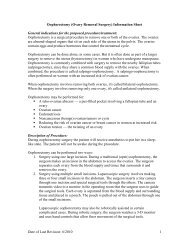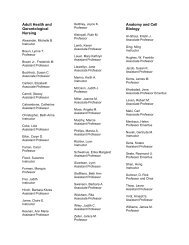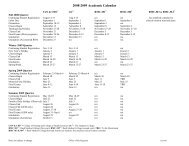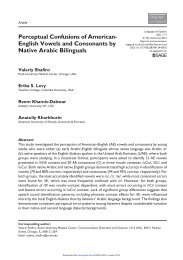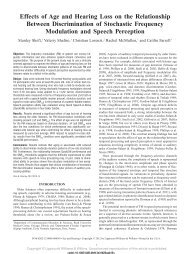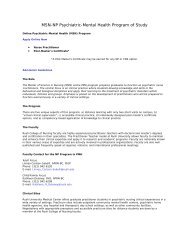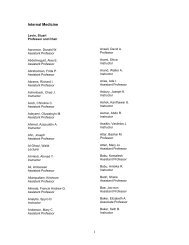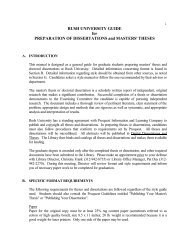Perceptual confusions of American English vowels ... - Rush University
Perceptual confusions of American English vowels ... - Rush University
Perceptual confusions of American English vowels ... - Rush University
Create successful ePaper yourself
Turn your PDF publications into a flip-book with our unique Google optimized e-Paper software.
<strong>English</strong> word that contained a similar vowel with normal feedback. The results<br />
were compared with data from <strong>English</strong> controls and suggest that the<br />
compensatory behavior is not language dependent.<br />
4pSW29. Linguistic experience’s influence on foreign accent detection in<br />
short, slightly accented speech. Hanyong Park Speech Res. Lab., Indiana<br />
Univ., 1101 E. 10th St., Bloomington, IN 47405, hanypark@indiana.edu<br />
This study examined how a listener’s linguistic experience affects the<br />
detection <strong>of</strong> foreign accent in short, slightly accented speech. Two factors<br />
were considered: Age <strong>of</strong> arrival in a second-language L2 speaking country<br />
AOA, and length <strong>of</strong> residence in that country LOR. Two listener groups<br />
with the same native language L1: Korean but with different AOA and<br />
LOR judged the nativeness <strong>of</strong> short stimuli produced by 4 Korean-<strong>English</strong><br />
bilinguals and 2 native speakers <strong>of</strong> <strong>American</strong> <strong>English</strong>. The stimulus length<br />
ranged from the vowel /a/ to monosyllabic and disyllabic <strong>English</strong> words. To<br />
investigate the listeners’ sensitivity patterns to different linguistic structure,<br />
the monosyllabic corpus included stimuli having both natural i.e., CV and<br />
unnatural syllable structures i.e., CCV, CVC, and CCVC as well as various<br />
segments in terms <strong>of</strong> Korean phonotactics. Results show that: 1 more experienced<br />
with L2 led to higher sensitivity to a foreign accent; 2 AOA affects<br />
foreign accent detection more than LOR; and 3 the non-native listeners<br />
were not sensitive to different linguistic structures, except in different<br />
CCV types by the more experienced listeners. The results suggest that a listener’s<br />
sensitivity to a foreign accent develops up to a certain degree, according<br />
to L2 experience.<br />
4pSW30. Asymmetries in the mismatch negativity response to <strong>vowels</strong> by<br />
French, <strong>English</strong>, and bilingual adults: Evidence for a language-universal<br />
bias. Linda Polka, Monika Molnar, Shari Baum School <strong>of</strong> Commun. Sci.<br />
and Disord., McGill Univ., 1266 Pine Ave. W., Montreal, QC Canada,<br />
linda.polka@McGill.ca, Lucie Menard Universite du Qubec à Montréal,<br />
QC Canada, and Karsten Steinhauer McGill Univ., Montreal, QC, Canada<br />
In infants, discrimination <strong>of</strong> a vowel change presented in one direction is<br />
<strong>of</strong>ten significantly better compared to the same change presented in the reverse<br />
direction. These directional asymmetries reveal a language-universal<br />
bias favoring <strong>vowels</strong> with extreme articulatory-acoustic properties<br />
peripheral in F1/F2 vowel space. In adults, asymmetries are observed for<br />
non-native but not for native vowel contrasts. To examine neurophysiological<br />
correlates <strong>of</strong> these asymmetries we recorded MMN responses from<br />
monolingual <strong>English</strong>, French and simultaneous bilingual <strong>English</strong>/French<br />
adults using an oddball paradigm with four <strong>vowels</strong>: <strong>English</strong> u, French u,<br />
French y, and an acoustically-distinct y. All <strong>vowels</strong> were tested in four<br />
conditions with each vowel serving as deviant and standard. Within each<br />
vowel pair, MMN responses were larger and earlier when the deviant vowel<br />
was more peripheral. This pattern was consistent across the language groups<br />
and was observed for within-category within u; within y and for crosscategory<br />
vowel pairs u versus y. Findings indicate that a bias favoring<br />
peripheral <strong>vowels</strong> is retained in the neural pre-attentive processing <strong>of</strong> <strong>vowels</strong><br />
in adults. As in infant behavioral findings, this bias is independent <strong>of</strong> the<br />
functional status <strong>of</strong> the vowel pair. Implications for the natural referent<br />
vowel model Polka and Bohn 2003 will be discussed.<br />
4pSW31. The effect <strong>of</strong> accent on toddlers’ story comprehension and<br />
word recognition. Brittan A. Barker and Lindsay E. Meyer Dept. <strong>of</strong><br />
COMD, Louisiana State Univ., 63 Hatcher Hall, Baton Rouge, LA 70803<br />
The current study sought to enrich the developmental research and contribute<br />
to the ever-growing knowledge about talker-specific spoken language<br />
processing by examining the affect <strong>of</strong> accent on toddlers’ ability to comprehend<br />
a story. A total <strong>of</strong> 24 children aged 30–42 months participated in the<br />
first study employing a between-subjects design. Talker accent native versus<br />
non-native served as the independent variable and story comprehension<br />
accuracy served as the dependent variable. It was predicted that the children<br />
listening to the story in their native accent would perform significantly better<br />
on the comprehension task than those listening to the non-native accent. The<br />
hypothesis was not supported; there was no significant difference between<br />
the listeners’ performance t22.169, p.05. An ongoing, follow-up<br />
study was conducted to further explore the surprising results. The affect <strong>of</strong><br />
accent on word recognition skills in these same children is currently being<br />
tested. The complete data set <strong>of</strong> the second study will be presented. It is<br />
hypothesized that the toddlers will have significantly more difficulty recognizing<br />
the words spoken in a non-native accent. These results would echo<br />
previous talker-specific word recognition results Ryalls and Pisoni 1997<br />
and suggest that talker-specific information may affect low-level speech perception<br />
but not higher-level language comprehension.<br />
4pSW32. Cross-linguistic variation in language similarity classification.<br />
MaryAnn Walter Dept. <strong>of</strong> Linguist., Northwestern Univ., 2016 Sheridan<br />
Rd., Evanston, IL 60208, m-walter@northwestern.edu<br />
This study aims at identifying factors that make language sound structures<br />
seem more or less similar to <strong>English</strong>, and how those similarity judgments<br />
change according to the listener’s native language. Listeners from<br />
four different native language groups <strong>English</strong>, Mandarin Chinese, Korean,<br />
and Turkish sorted a group <strong>of</strong> 17 genetically and geographically diverse<br />
languages in terms <strong>of</strong> their sound-based distance from <strong>English</strong>. Placements<br />
<strong>of</strong> individual languages were analyzed, as well as groupings <strong>of</strong> similarly<br />
ranked languages and correlations among overall ranking structures <strong>of</strong> the<br />
different groups. Bilingual listeners exhibit more variability in their rankings<br />
than monolingual <strong>English</strong> speakers, rank their own language as less similar<br />
to <strong>English</strong> than other groups do, and rank languages <strong>of</strong> neighboring groups<br />
the least similar to it <strong>of</strong> all. Ranking correlations between language groups<br />
are significant, varying somewhat in magnitude depending on geographical<br />
proximity and typological/genetic relatedness <strong>of</strong> the listener group<br />
languages. This reflects the presence <strong>of</strong> consistent groupings within ranking<br />
structures for all language groups, which depend on sound-based factors<br />
such as the presence <strong>of</strong> perceptually salient speech sounds. These results enable<br />
predictions about relative intelligibility among international <strong>English</strong> users,<br />
native and non-native. Work supported by a Mellon Postdoctoral Fellowship<br />
awarded by the Woodrow Wilson Foundation.<br />
4pSW33. Acoustic similarities between front rounded and back<br />
unrounded <strong>vowels</strong> as evidenced by French /ø/ and /u/ produced by<br />
Japanese-speaking learners. Takeki Kamiyama Laboratoire de Phonetique<br />
et Phonologie UMR 7018 CNRS/Sorbonne Nouvelle, 19, rue des Bernardins,<br />
75005 Paris, France, Takeki.Kamiyama@univ-paris3.fr<br />
French high back rounded /u/ is characterized by a concentration <strong>of</strong> energy<br />
in the low frequency zone 1000 Hz due to the grouping <strong>of</strong> the first<br />
two formants, and midhigh front rounded /ø/ by a balanced distribution <strong>of</strong><br />
formants, with F2 located around 1500 Hz. Japanese-speaking learners <strong>of</strong><br />
French JSL, who have difficulty differentiating /ø/ and /u/ both in perception<br />
and production, tend to produce, for both, Japanese-like /u/, which is<br />
fronted and less rounded, with a formant structure similar to that <strong>of</strong> French<br />
/ø/. Our perception experiment using 18 tokens each <strong>of</strong> /u y ø/ produced by<br />
five JSL shows that the 16 native speakers <strong>of</strong> French NF tested perceived<br />
mainly /ø/ when they heard those stimuli intended as /u/ by JSL but produced<br />
with a high F2 between 1100 and 1600 Hz, with a mean goodness<br />
rating <strong>of</strong> 2–4.5 out <strong>of</strong> 5 for /ø/. Another perception test conducted with<br />
stimuli synthesized using Maeda’s articulatory synthesis VTCalcs shows<br />
that the 16 NF examined tended to identify <strong>vowels</strong> synthesized as front<br />
rounded <strong>vowels</strong> and back unrounded <strong>vowels</strong> both as front unrounded ones<br />
/ø/ and /æ/, respectively, which indicates the acoustic similarities <strong>of</strong> both<br />
types <strong>of</strong> <strong>vowels</strong>.<br />
4pSW34. Relation <strong>of</strong> perception training to production <strong>of</strong> codas in<br />
<strong>English</strong> as a second language. Teresa Lopez-Soto Dept. <strong>of</strong> <strong>English</strong> Lang.,<br />
Univ. <strong>of</strong> Seville, Palos de la Frontera, Sevilla 41004, Spain and Indiana<br />
Univ., Bloomington, IN 47405 and Diane Kewley-Port Indiana Univ.,<br />
Bloomington, IN 47405<br />
A preliminary study has been conducted to discover whether moderate<br />
amounts <strong>of</strong> speech perception training improve accurate production even<br />
though production is not trained. The study recruited one group <strong>of</strong> eight<br />
Spanish adults who had resided less than 10 years in the USA. A set <strong>of</strong> 13<br />
word-final <strong>English</strong> consonants was selected for training from a SPATS s<strong>of</strong>tware<br />
module. On days 1 and 5, the group participated in both perception and<br />
production tasks with the 13 codas pre- and post-tests. On days 2–4, the<br />
group trained with feedback for 1hmostly with VC syllables and occasionally<br />
with sentences speech recorded from multiple talkers. Results show:<br />
1 with 3 h training, Spanish listeners’ perception improved significantly<br />
across the 13 codas, with greater improvement on consonant clusters than on<br />
singletons; 2 for consonants not accurately produced in the pretest, many<br />
substantially improved after only perception training; 3 several consonants<br />
2756 J. Acoust. Soc. Am., Vol. 125, No. 4, Pt. 2, April 2009 157th Meeting: Acoustical Society <strong>of</strong> America 2756



